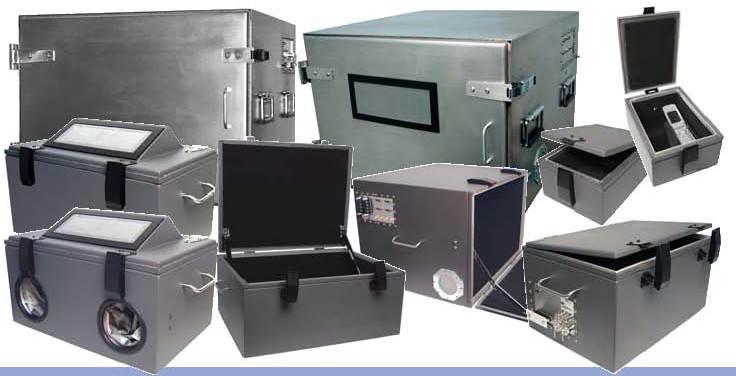Innovative RF Chamber Rochester: Developments in Electronic Shielding
Innovative RF Chamber Rochester: Developments in Electronic Shielding
Blog Article
Discovering the Adaptability of Protected Test Units in Different Electronic Examining Circumstances
In the realm of digital testing, the value of shielded examination rooms can not be overemphasized. From electro-magnetic compatibility testing to signal honesty assessments and beyond, protected examination rooms offer a level of accuracy and control that is important in today's facility electronic landscape.
Significance of Shielded Test Units
The value of shielded examination enclosures in digital testing can not be overstated as a result of their crucial function in making certain precise and dependable examination outcomes. Secured examination rooms offer a controlled screening atmosphere by protecting against outside electro-magnetic disturbance from impacting the performance of digital tools under test. This protecting is crucial for maintaining the integrity of the testing procedure, especially when taking care of sensitive parts or signals that can be easily affected by outside variables.

Basically, the significance of secured test units lies in their capacity to create a secure and interference-free screening environment, eventually adding to the accuracy, integrity, and integrity of electronic screening processes.

Applications in Electromagnetic Compatibility Testing
With the fundamental function of shielded test units in making sure reputable and precise digital screening results established, their application in electro-magnetic compatibility testing arises as an important aspect in confirming the resilience of electronic devices versus outside electro-magnetic interference. In electromagnetic compatibility testing, secured test enclosures play a crucial function in developing regulated testing atmospheres that resemble real-world electromagnetic problems. Overall, protected examination enclosures are crucial tools in electro-magnetic compatibility testing, supplying a controlled environment for exact assessment and validation of digital devices' resilience against electro-magnetic interference.
Enhancing Signal Stability Examining
Just how can protected examination units raise the accuracy of signal stability testing in digital tools? Shielded test rooms play a critical function in enhancing signal integrity screening by supplying a regulated setting that minimizes exterior interference and noise. These rooms produce a secured room that separates the gadget under test from outside electromagnetic fields, guaranteeing that the signals being determined precisely stand for the tool's real efficiency.
By decreasing electromagnetic interference, secured test units help designers attain a lot more trusted and exact measurements of signal integrity specifications such as surge jitter, crosstalk, and time. This precision is essential for assessing the high quality see page of high-speed electronic signals and guaranteeing that electronic gadgets fulfill market criteria for performance and dependability.
Furthermore, protected rooms allow engineers to mimic real-world operating problems by developing a regulated electromagnetic setting. This ability is particularly beneficial for signal honesty testing in devices that are sensitive to external electromagnetic interference, such as cordless communication systems and high-speed information networks.
Versatility in IoT Gadget Testing
Versatility plays an essential duty in efficiently examining IoT gadgets for their capability and performance across diverse situations. IoT tools incorporate a broad variety of interconnected devices, from sensing units and actuators to complicated smart systems. Checking the functionality and performance of these devices requires a flexible approach that can adjust to the various interaction protocols, regularities, and environmental conditions that IoT tools operate in.
Shielded examination enclosures supply the adaptability needed for screening IoT devices by providing a regulated testing setting that can imitate real-world problems while making certain precise and reputable results. These rooms can shield versus electromagnetic disturbance, imitate different RF settings, and give a controlled temperature and humidity setup, enabling for thorough screening of IoT gadgets in various situations.
Furthermore, the adaptability of protected test enclosures enables engineers to check IoT gadgets under various network conditions, power levels, and signal staminas, making sure that the gadgets can perform ideally in diverse IoT deployment circumstances. By utilizing shielded examination units for IoT device screening, engineers can validate the capability, performance, and dependability of these devices across a large range of real-world problems, eventually causing the development of durable and effective IoT services.
Role in RF and Wireless Testing
Protected test units play a crucial function in guaranteeing the go to these guys accuracy and reliability of RF and wireless testing for digital tools (rf shielded test enclosure rochester). These enclosures give an isolated screening setting cost-free from outside interference, permitting engineers to determine the real efficiency of RF circuits and wireless interaction systems. By developing a protected room, these rooms protect against signals from running away and block outside signals from getting in, enabling precise measurements and consistent results
In RF screening, secured examination units are crucial for examining the efficiency of antennas, transmitters, receivers, and various other RF components. The controlled setting within the enclosure assists in characterizing the radiation patterns, signal stamina, and frequency action of RF tools accurately. In wireless testing circumstances, these enclosures mimic real-world conditions while ensuring check that signals continue to be consisted of within the test setup, without triggering disturbance to external systems.
Conclusion
In final thought, protected examination units play an important duty in various digital screening scenarios such as electromagnetic compatibility screening, signal integrity screening, IoT tool testing, and RF and cordless screening. Their versatility permits for the reputable and precise testing of electronic tools in regulated atmospheres, ensuring optimum performance and performance. On the whole, shielded test enclosures are important devices in the field of electronic devices testing, supplying a secured environment for precise dimensions and evaluation.

Report this page